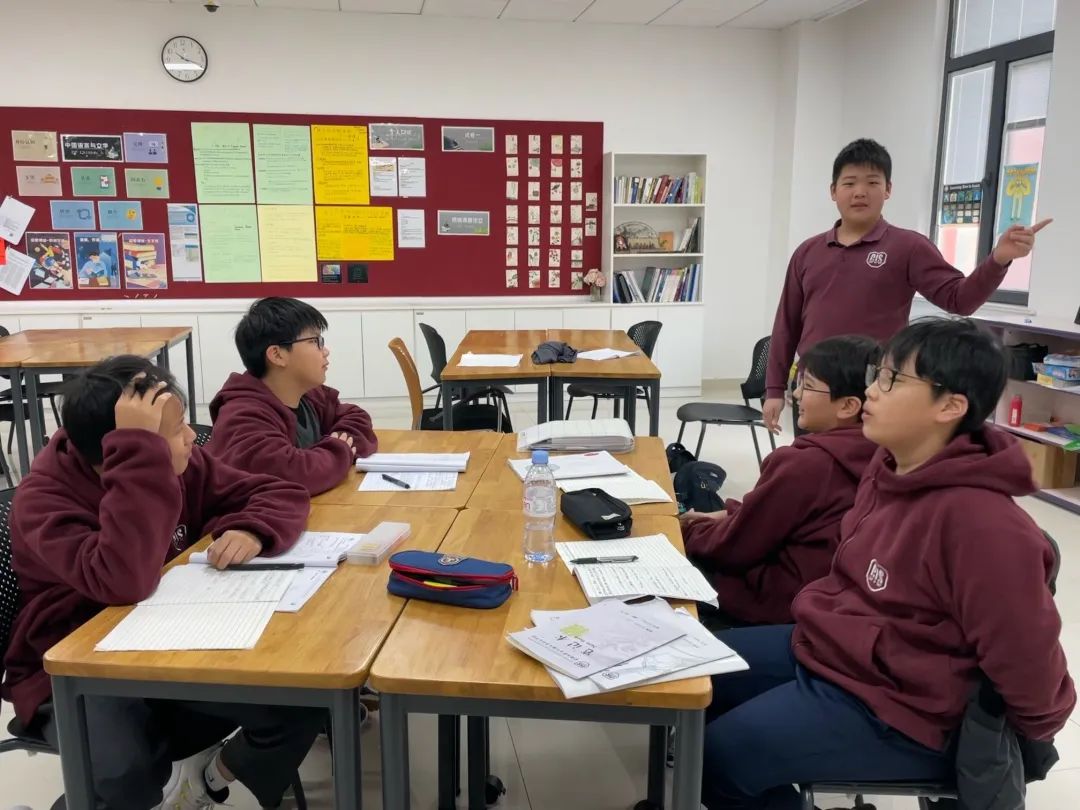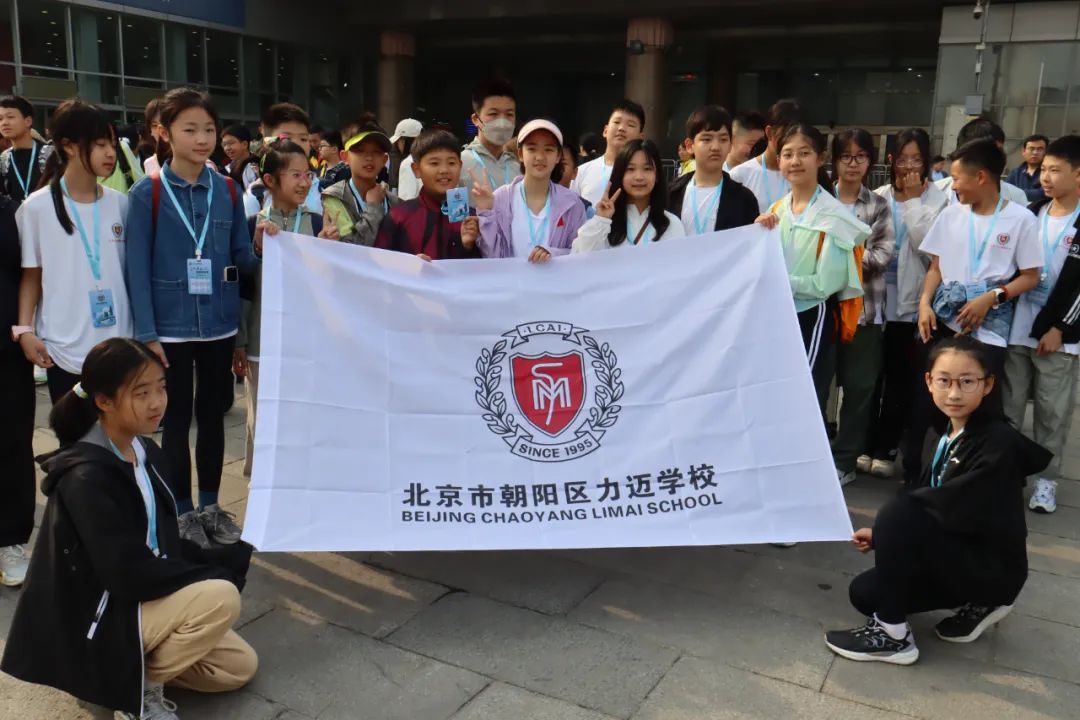2023-11-30发布于安徽
Mandarin Highlights
CISH




G6 (Mr. Du & Ms. Fiona)
In Mr. Du’s and Ms. Fiona’s grade 6 Language and Literature class, students have been unit 2 Expressing Feeling and Ambitions. To improve students’ speaking and communicating skills, grade 6 students explore the knowledge that they are interested in but not very familiar with such as idioms, literary devices, important literature knowledge and then share their learning with their peers in five minutes. They have been making improvements in thinking and communicating. Meanwhile, they improve their speaking skills and increase their confidence in speaking in front of people.

G6 (Ms. Summer)
In Ms. Summer's G6 Mandarin Language Acquisition class, students did a lot of reviewing practice to prepare for the coming Summative Assessment of our first unit. This assessment was designed to evaluate their overall language acquisition progress and their ability to apply the knowledge and skills they had acquired throughout the unit. The assessment included listening, speaking, reading, and writing components, allowing students to showcase their comprehensive language abilities.



G7 (Ms. Summer & Ms.Miko)
In Ms. Summer & Ms. Miko’s G7 Chinese language and literature class, this week we just started learning Unit 2–Poem. This unit will lead the students into love, fondness, and study of poems through the research of the method and meaning of the cultivation motivation, and review of the interest of poems, under the theory of interest, receptive esthetics.




G7 (Ms. Echo)
In Ms. Echo’s class, grade 8 language acquisition phase 5 students have been learning the lesson of learning Chinese. We sparked among the students by watching a hilarious video of learning Chinese, and together we discussed the difficulties encountered in the process of learning Mandarin and ways to improve. After studying new vocabulary and grammar in texts, we reinforced our learning through sorting exercises. The topics are closely related to daily life, and the students enjoy learning!

G8 (Ms. Lisa)
In Ms. Lisa’s G.8 Chinese language and literature class, we started our second inquiry unit ‘Literary Study’ in the context of Identities and Relationships. We focused on the key concept Communication and related concepts Point of View and Purpose. Students started their journey through exploring the new genre-Prose. Some students did a very good job in introducing the definition, features and categories of prose, and analyzing a famous writer’s prose. They practiced their research and communication skills during the exploring.



G9 (Ms. Tina)
In Ms. Tina's G9 Chinese language and literature class, this week, students continued to study Unit 2 Oratory. We talked about a classical Chinese article “唐雎不辱使命”. They not only learned important words in the text, but also learned techniques for debate and persuasion. Finally, they analyzed and understood the characters in the text through a series of exploratory activities.




G9 (Ms. Lisa)
In Ms. Lisa’s G.9 Mandarin Language Acquisition class, students have been learning our second inquiry unit ‘Self-enhancement’ in the global context of Globalization and Sustainability. We focused on the key concept of Connections and related concepts of Word Choice. Students practiced and made drills of vocabulary, sentences and texts in different ways every day. They also developed their communication skills through various activities.
G10 (Ms. Echo & Ms. Miko)
In Ms. Echo and Miko's grade 10 language literature has been learning the unit of the prose. Feng Zikai's philosophy of life, attitude towards life, and aesthetic taste all exhibit a strong Buddhist influence. His prose is able to find the various aspects of life that align with Buddhist principles in the ordinary and mundane. On one hand, his prose showcases his enlightenment on trivial matters of life, while on the other hand, he hopes to evoke resonance within readers. Through studying "The White Goose," students carefully depicted the image of the white goose through detailed descriptions by the author and used the original text to analyze their own creations. This approach combines education with entertainment. Students enjoyed it.
Slide pictures to see more
G11 & G12 Chinese A (Ms. Miko & Ms. Michelle)
This week, students in Ms.Miko’s G11 Chinese A have been studying three different works from Lu Xun, comparing and contrasting the different feelings that the novel's narrative techniques bring to the reader. In the process, students gradually mastered the method of comparative reading, which prepared them for Paper 2 and then the first MOCK IA.
In Ms. Michelle’s G12, IBDP2 students were preparing their IA. We encouraged students to break down the IA draft into small pieces. And each of them had a clear timeline of the process. They learned how to handle a long-term goal during this process. Next week, we will finish all the IA drafts and students will have time to practice their speech.
G11 & G12 Chinese B / ab initio
In Mandarin AB initio, students have been learning the unit Experience, and students learned how to describe their daily routine. Students played a translation game Snakes and Ladders. By playing this game, students reviewed the newly learned grammar and new expressions and practiced how to use their learning while having fun, at the same time, students communicated with each other and helped each other.



Arts Highlights
CISH

EY Arts
Class Photos




Pre-K (Evan Kirby)
This week in PreK we went on many adventures through the great big colorful world! We took a short walk and identified colors out in the world! Finding all the colors we could was so much fun! We also practiced sorting our colors and seeing if we could place them into their correct spots. Lastly we played a follow the leader game to help our ability to identify what colors we are interacting with. What a lovely week!






K1 (Evan Kirby)
This week in K1 we are starting our new unit called “The Elements and Principles of Art”. We had many fun creative learning stations such as stencils, paper cutting, free drawing, as well as geo-shape puzzles. All the while each of us got to come up and create a rainbow star by mixing our own primary and secondary colors. We also got to practice different types of brush strokes. Great work everyone!

Slide pictures to see more
K2 (Evan Kirby)
This week in K2 we are creating color wheels! Learning about primary and secondary colors can be such a fun activity! Each student got to create their own color wheel and work alongside their peers in this group project. I am so proud of how well the students worked together!


K3 (Evan Kirby)
This week in K3 we began our new unit called “The Elements and Principles of Art”. In this unit we will be learning about the fundamentals that make up all works of art. Today we were studying texture by making relief prints of leaves, stencils, and other textured surfaces we found in the art room. We really had such a wonderful time! Great work everyone, so proud of you all!







Grade 1 (Katija Bogdanic)
This week we learned about the artist Henri Matisse and his famous series of work called “The Cut-Outs”. In the late 1940s when Matisse was in the final chapter of his long artist career, he turned towards making paintings exclusively out of paper and scissors. We read a lovely book called Henri's Scissors by Jeanette Winter and responded to the artist’s use of color, and layering. We then made our very own animals inspired by the techniques used by Matisse.





Grade 2 (Katija Bogdanic)
After completing the last step of our Paul Klee inspired landscapes, we engaged in a critical and constructive gallery discussion of our final works. In line with our Culture in Art unit of inquiry, students paired into groups and researched the history and traditions of weaving. We learned about different types of looms and responded to textiles from different cultures. Students started their very own woven art using hand looms and yarn.





Grade 3 (Katija Bogdanic)
Third graders presented their landscape paintings during a gallery discussion where they critically and respectfully responded to each other’s final work. Students were asked to reflect on the use of fauvist color palette, pattern, vanishing point, and overall composition. In line with the homeroom unit of inquiry, we started our next project which involves combining our poems with art.



Grade 4 (Katija Bogdanic)
This week we finalized our stories, characters, and script for our stop-motion animation movies. Students are paired into groups and working on constructing two different sets for their movies using a wide range of materials.




Grade 5 (Katija Bogdanic)
This week we are adding color to our ancient civilization quilted landscapes. Students are being mindful of layering their compositions and using their embroidery skills to combine the fabric elements together.
MYP Arts
Class Photos




Grade 6 (Roxane Joubert)
This week our Grade 6 students began their investigation of UNIT 2: “From Micro to Macro”. They learned about the fascinating world of scale, discovering connections between small and large imagery. Engaging with microscopes, drawing apps, sketching challenges and researching microscopic and macroscopic images, they laid the groundwork for their Criterion A research component. This unit is a fusion of art and science, encouraging questions about perspective, scale, and our place in the universe. Stay tuned for their creative interpretations and colourful abstractions!



Grade 7 (Roxane Joubert)
Our Grade 7 Visual Arts class students continued their practical exploration of "Masks of the World". They constructed armatures for their clay masks, assembling cardboard and wired structures to ensure the clay maintains stability and integrity during the drying process. In the theoretical component, students engaged in comparative analysis using thinking maps to explore traditional masks from the Himalayas and the Indian sub-continent. They observed and documented similarities in colour, shape, and purpose across Tibetan, Bhutanese, Nepalese, Indian, and Sri-Lankan mask-making traditions.



Grade 8 (Roxane Joubert)
Grade 8 Visual Arts students were introduced to UNIT 2: "Understanding Linear Perspective: One-Point Perspective." They studied basic line types, familiarised themselves with their drawing boards, and successfully completed their initial foundational drawing challenge. Throughout this unit, students will uncover the roots and impact of linear perspective in the Visual Arts, connecting it with Geometry as an IDU. The focus will remain on one-point linear perspective activities and a summative assessment of a one-point perspective room interior. This unit will emphasise object scale, use of cylinders, cubes, spheres, vanishing points, views, perspective and foreshortening.





Grade 9 (Lucian Stefanescu)
A relatively new medium similar with woodblock printing technique, linocut appeared in the contemporary art world as an established professional print medium at the beginning of twentieth century, promoted by artists like Pablo Picasso and Henri Matisse. Linocut is a type of relief printing technique in which an image is carved into a block of linoleum, then ink is rolled onto the uncut surface, paper is placed on top of the block and, finally, pressure is applied to produce the print. During this unit, students will be guided through historical, cultural and conceptual aspects of printmaking with a focus on linocut printing technique.
This week, Grade 9 students continued working on their sketches of ideas for their linocut print.


Grade 10 (Lucian Stefanescu)
Drypoint is an engraving method in which the design to be printed is scratched directly into a copperplate with a sharply pointed instrument. Lines in a drypoint print are characterized by a soft fuzziness caused by ink printed from a burr, a rough ridge of metal thrown up on each side of the furrow of the drypoint line. Drypoint is most often used together with other printmaking techniques like monoprint or monotype in which the image created can only made once. This allows for more unique creations, but with more flexibility, as a combination of monoprinting techniques including printing, drawing, and painting can be used. During this unit, class activities will give students an opportunity to practice art fundamentals while learning technical skills in printmaking.
This week, Grade 10 students continued working on their sketches of ideas for their drypoint prints, while some of them started working on their plates.










Grade 12 (Lucian Stefanescu)
In New Brunswick Programme, our student continued continued working on her portfolio and started adding her first artworks in her exhibition file.


EY Music

Pre-K (Darren Bayotlang)
What a fun week we had with Pre-K students! "Trot to Grandma's House" that helped us practice keeping a steady beat, we also got explore “Tempos” that go fast and slow, which was so much fun! The best part was using maracas. We're getting really good at holding them and using them to make music. Great job, Pre-K!

K1 (Darren Bayotlang)
Music is a fun way to express ourselves. This week with the K1's we explored the song "Trot to Grandma's House" and learned about tempos like fast and slow. By playing the maracas, we became more familiar with the rhythm of the music. It's amazing how music can make us feel different emotions. Keep up the great work, K1!


K2 (Darren Bayotlang)
This week with the K2 students , we continued our exploration of discovering different celebrations and described how music makes us feel when it's fast or slow. We explored the song "Poppies Red" to remember the people who help us daily. We also had fun learning an instrument activity with "Trot to Grandma's House," where we focused on identifying fast and slow "Tempos".

PYP Music
Class Photos




Grade 1 (Snow Boudreau)
In Grade 1, students delved into "I'm the Happiest Christmas Tree," which not only introduced them to a seasonal classic but also honed their understanding of melody and rhythm. This song is an integral part of our early instruction, introducing young learners to the joy of music.

Grade 2 (Snow Boudreau)
Grade 2 students embarked on an exploration of "The Fa La La Song," which allowed them to practice both melody and rhythm. This song has been a valuable addition to our curriculum, nurturing the students' vocal skills while enhancing their sense of musical timing.
Slide pictures to see more
Grade 3 (Snow Boudreau)
Grade 3 students were actively engaged in a dynamic component of our program by practicing a dance song. This activity aimed to foster coordination and rhythm, fundamental skills that form the core of our music education.


Slide pictures to see more
Grade 4 (Snow Boudreau)
In Grade 4, students showcased their musical growth with "Let It Be Christmas." This song is an example of the more advanced pieces incorporated into our program, offering opportunities for students to deepen their appreciation for music and develop their vocal abilities.




Grade 5 (Snow Boudreau)
Grade 5 students diligently continued their preparation for the Winter Concert, a central aspect of our PYP program. They employed bucket drums to enhance their musical skills, providing a hands-on learning experience and preparing for their performance in the event.

Grade 6 (Jose Correia)
It's working the unit "An Introduction to Theatre," offers students an exciting exploration of the captivating world of theatre. Throughout the course, students will become familiar with essential theatre terminology, discover the diverse practices of theatre around the globe, and engage in a variety of stimulating activities such as script work and devising.

Grade 8 (Jose Correia)
The grade 8 worked on body percussion with harmony, in which they had to compose a harmonic sequence with melody, snapping fingers, clapping, chest, legs and vocal sounds, now starting to prepare the performance for the winter concert.


Grade 9 (Jose Correia)
In this unit students will explore the performance and analysis of a piece of music in which they have to choose a piece and analyze it in detail using four of the musical elements, now they started preparing the performance for the concert.


Grade 10 (Jose Correia)
They are working in the IB Areas of Inquiry (World Music for sociocultural and political expression, listening and performance, dramatic impact, movement and entertainment, technology in the electronic and digital age, At the moment they are working on musical pieces with drama for the performance.


MYP Drama
Class Photos




Grade 7 (Jonny Turvey)
This week in Grade 7 Drama, the students engaged in an exciting and collaborative process of script development. They began by voting on their favorite student-written scripts, fostering a sense of ownership and inclusion within the class. Once the scripts were selected, the students broke into two casts. This division provided them with a platform to explore their chosen scripts, look deeper into character development, and bring their unique visions to life. Through active participation and cooperation, the students demonstrated a growing enthusiasm for theater, showcasing their creativity and teamwork skills.

Grade 10 (Jonny Turvey)
This week in Grade 10 Drama, the students have been preparing for their upcoming performance at the winter concert. Their focus has been on perfecting the technical aspects of the production, particularly the light and sound design. They have also dedicated time to practicing their dance routine, synchronizing their movements and refining their choreography.




声明:本文内容为国际教育号作者发布,不代表国际教育网的观点和立场,本平台仅提供信息存储服务。
全国500所国际学校大全 / 3分钟匹配5-8所 / 1年名校升学备考托管服务





